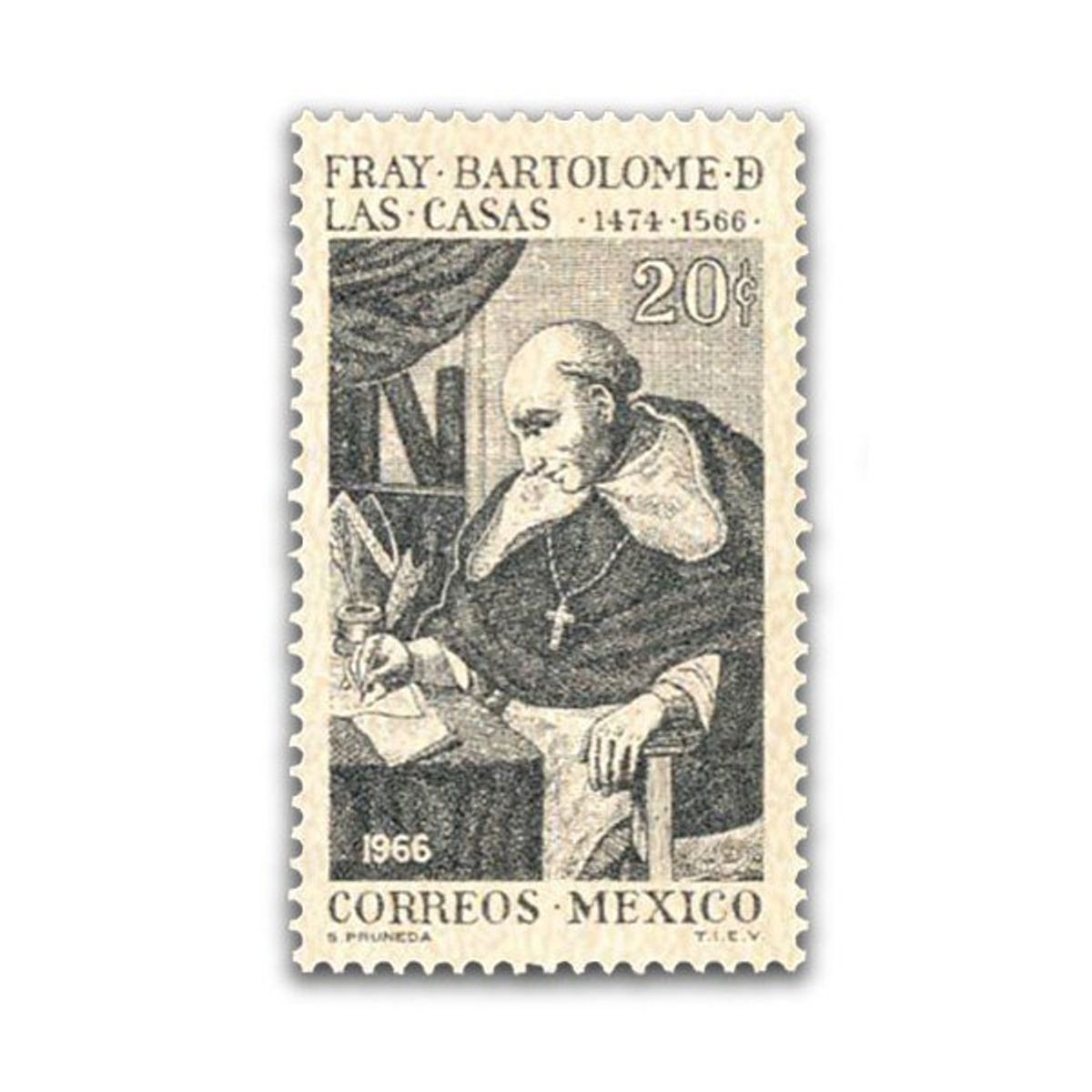The desecration of the native peoples as a whole came to a head after the invasion of the Caribbean and South America by Columbus and Cortes. Many dead, dying, and hungry were to be found in these so-called “new” lands. After the establishment of Christian priests and friars, those who proposed the Christianization of the natives started to see that those who invaded weren’t Christian at all, and didn’t exhibit Christian values. One fray in particular, Bartolome de Las Casas, presented a perspectivist view of the cultures of the native people. Originally an owner of several encomiendas, he renounced them after he saw the natives dying of hunger in the streets and worked absolutely to the bone.
Las Casas took his stance even further, especially after listening to a sermon from fray Anton de Montesinos in 1511. It was after this that he renounced the Spanish conquistador way of life. There have been opposing sides of the issue as well as different interpretations. One comes from Dr. Gines Sepulveda, who argued that the conquest and the subsequent war against the natives was possibly justified. Due to this prevailing attitude, Las Casas presented to the world, in his written memoirs, and absolutely new way of thinking. This is called the perspectivist view. These writings offer hope that future destructiveness can be prevented when two or more cultures clash.
After Las Casas saw how devastated the native peoples were, he retired into a moratorium. Here, he decided to think of a way where cultures could come together, have common goals, and prevent war. He was brought to the Indies in order to implement Christianity to the native peoples. Problem was, they were never exactly given a choice. They were forced to comply with whatever rules were set forth. The moratorium allowed him to write his volumes, after he gave up his encomiendas. This was in the 1510s and his work wasn’t finished until the 1560s. This truly shows his dedication to the plight of the native population and a resolution for their suffering.
Montesinos gave a sermon in 1511, explaining how the natives should ultimately be treated. The powers that be became involved and decided that the sermon should be retracted, but the fray refused. The colonists who opposed his sermon sent a message to the king asking for the retraction. Due to his refusal, he was threatened with losing his encomiendas. He then became an ambassador for the natives, travelling back and forth from the Americas to Europe to plead the natives case.
Voldivia, a prominent scholar, takes the side of the conquistadors, especially in regards to their treatment of the native population. During this time, the distinction between scholar and activist did not exist. Due to a limited group of educated people, commoners tended to believe those who were educated. Thus, scholars had the power to persuade people’s opinions. The concept proposed by Valdivia was that this war in question was a just war. The native people had to be Christianized for the sake of humanity. Christians at the time believed that their religion was the supreme religion, or in other words, the right one or only one. The only way to true salvation was to be a practicing Christian.
This is where we see perspectivism come into play. We must examine things from all perspectives, from all sides. Oviedo, the official historian of the Spanish crown, helped to decide whether or not the conquest was justified. He determined that all people have the right to trade freely. The Indians could not stop this cause. Yet, it is impossible to examine things from the natives perspective due to the language barrier. The Spanish saw the natives as barbarians, literally because they didn’t speak the same language, and weren’t necessarily willing to learn it.
Sepulveda, another scholar on the subject, had a different opinion. He genuinely believed that some people were born inferior to others. Some are born masters, some are born slaves. The only way for the natives to truly be equal to those that conquered them was to become Christian. New laws were passed by the papacy in 1542. They abolished native slavery, as they now considered the natives to be fully human and fully equal. This was a stark contrast to what was originally thought by people like Columbus and Cortes, who ultimately discerned that the Spanish were superior to the natives as well as seeing them as objects and not people.
The conquest of the Americas then turned into killing for political motivation. They killed people to send messages to those who refused to convert. The debate lies in whether or not the Christian religion should be imposed or proposed. At this point, it was just being imposed. The natives didn’t have a choice. They would be more likely to convert if Christianity was proposed, meaning that they had a choice.
Las Casas had a different, and ultimately better, approach. He felt that the only way to make people Christian and to propose Spanish cultures to them was with love, acceptance, and understanding. This was his form of assimilation. He even reflected on human sacrifice by the Aztec people when he wrote his memoirs, relating it to the Christian religion. The natives were seen as the Spanish as inferior, or “savage”, due to this practice.
Las Casas said that sacrifice is a condemnable act, but we shouldn’t declare war on those that practice it. Of course, if the Spanish remedy was war, it would only kill more than the diseases ultimately did. The issue is with the native peoples law. If the law says that they should practice performing sacrifices, aren’t they only being good citizens by following the law? When Las Casas came to this realization, he proposed two solutions to the problem. This is where his perspectivist view truly comes into focus.
The first proposition aims at making sacrifice less strange and more acceptable. Las Casas argued that it isn’t very different from the Christian religion itself. He proposed the story of Abraham from the Old Testament, where he sacrificed his only son just because God had ask him too. This showed that Abraham was a true believer. It was also equated to a New Testament story, the one of Jesus and God, where God sacrificed his only son for the good of the people. Las Casas also tried to explain that cannibalism was driven by necessity of the natives, as they were starving due to Spanish rule.
The second proposition shows four different types of evidence to plead his case for fair treatment of the natives. These were listed in order, stating that the natives had an intuitive and primitive knowledge of God. They worshipped according to their own capacities. Sacrifice proved that they loved God, and also that they showed him gratitude. Sacrifice exists as a form of natural law, not human law.
We need to keep in mind that God is true for us and only us. What is common or universal is the idea of divinity, the religious rather than the actual religion. Las Casas even argued that the Aztecs were superior to the Christians when it came to their religious devotion. The love given to the natives should no longer be assimilatory in nature, but distributive, showing understanding and acceptance of each other’s differences. Each of us is the other’s barbarian.
It is important to note that Las Casas does not even prioritize his own religion. This can be seen as heretical in nature. For someone to say, in the 1560s, that Christianity is not the only, or the supreme, religion of the world can ultimately be seen as heresy. He argued that each man has the right to approach God by the path that suits him. This is in line with American thinking that we should all be able to have freedom of religion, so much so that it’s written in our Constitution. Yet, that wasn’t written until 1787. Las Casas was so revolutionary that he had these ideas in mind two hundred years prior.
While Columbus and Cortes conquered the Caribbean in the late 1400’s and early 1500’s, it is important to note that the change in opinion from “self and other”, as well as “objects”, to “assimilationist”, “love”, and “proposition” by Las Casas and the Dominican frays only took a short period of time, about ten years. Although Las Casas’ written work wasn’t published until the 1560s, he had these ideas in his head from the minute he heard the sermon in 1511. This only exacerbates the feeling of hatred towards Columbus and Cortes. They never tried to see things from the native's perspective. It was their way, or no way at all. They could never accept that anyone was different. By studying Las Casas, we can see that the feelings of Columbus and Cortes towards the natives were a dime a dozen. Most common people believed the stories they were told, as they were told them by scholars who were working directly with the king. It wasn’t until Las Casas became an ambassador did the royal family truly see what columbus and Cortes had done in the americas. Within thirty years or so, they had put a stop to the practice entirely. They saw how truly wrong it was. Las Casas shows us that the only way to understand those that are different is by giving them a choice. Imposing beliefs on people never works, even in the context of day to day conversations. We must accept people for who they are, not for who we wish them to be.


 Photo by
Photo by  Photo by
Photo by  Photo by
Photo by  Photo by
Photo by 


 people sitting on chair in front of computer
people sitting on chair in front of computer



 all stars lol GIF by Lifetime
all stars lol GIF by Lifetime two women talking while looking at laptop computerPhoto by
two women talking while looking at laptop computerPhoto by  shallow focus photography of two boys doing wacky facesPhoto by
shallow focus photography of two boys doing wacky facesPhoto by  happy birthday balloons with happy birthday textPhoto by
happy birthday balloons with happy birthday textPhoto by  itty-bitty living space." | The Genie shows Aladdin how… | Flickr
itty-bitty living space." | The Genie shows Aladdin how… | Flickr shallow focus photography of dog and catPhoto by
shallow focus photography of dog and catPhoto by  yellow Volkswagen van on roadPhoto by
yellow Volkswagen van on roadPhoto by  orange i have a crush on you neon light signagePhoto by
orange i have a crush on you neon light signagePhoto by  5 Tattoos Artist That Will Make You Want A Tattoo
5 Tattoos Artist That Will Make You Want A Tattoo woman biting pencil while sitting on chair in front of computer during daytimePhoto by
woman biting pencil while sitting on chair in front of computer during daytimePhoto by  a scrabbled wooden block spelling the word prizePhoto by
a scrabbled wooden block spelling the word prizePhoto by 
 StableDiffusion
StableDiffusion
 StableDiffusion
StableDiffusion
 StableDiffusion
StableDiffusion

 women sitting on rock near body of waterPhoto by
women sitting on rock near body of waterPhoto by 








